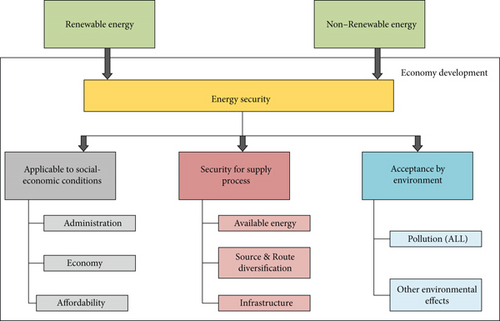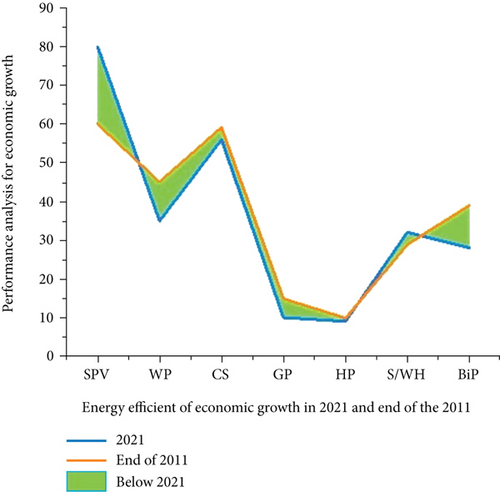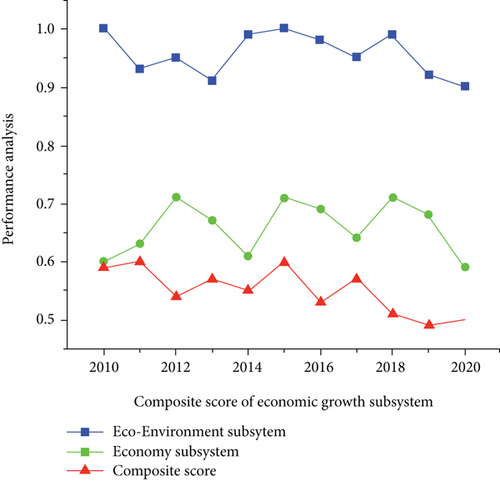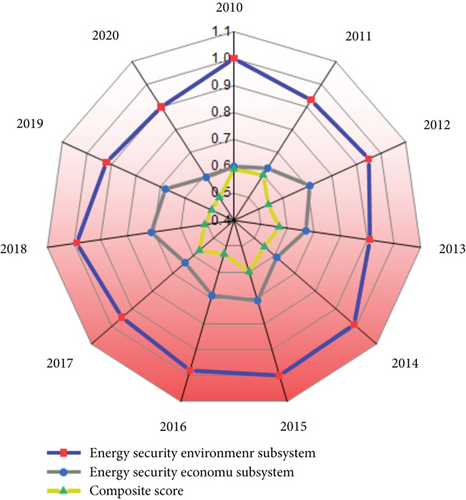Energy Security and Economic Development Based on Complex Computer System Dynamic Model
Abstract
Energy security has become the most prominent task during certain complex environmental conditions. In any part of the world, energy is the determinant of the country’s economy and hence needs to focus on developing the economy. Energy can be categorized as renewable and nonrenewable resources of the country; irrespective of the type, security has to be provided both at the demand and supply parts. Intelligent system is used for evaluating the economic development and energy security of the country. In this research, decision-making unit (DMU) method is implemented to predict the requirement of energy security and the economic development of the country through energy resources in the dynamic evolving world is considered. The study results proved that the proposed model helps in forecasting the need of economic development and energy security to a greater extent. The proposed model is compared with the existing fuzzy prediction model for the analysis, and it is observed that the proposed model has achieved 98.78% of accuracy in the economic prediction.
1. Introduction
The economy and urbanization have both increased substantially in the last few years. However, as the economy has developed, energy shortages and environmental degradation have worsened, making5 our efforts to protect the environment more difficult. Understanding complex systems and analysing dynamic system behaviour in the context of its wholeness are all components of the discipline of system dynamics [1]. Simulating in more detail supports a more robust simulation that can be relied on [2]. In socioeconomic dynamics, business systems, corporate planning and policy design, urban dynamics and analysis of city problems, agricultural systems, agricultural policy analysis, and ecological systems, many studies have used the system dynamic method to address or simulate scenarios [3], to name a few examples of how system dynamics can be used in energy-economy-environment systems research: environmental impact analysis; global environmental development planning; ecoindustrial systems planning; dynamic assessment of urban economies, resources, and the environment; and economic and environmentally sustainable development [4]. It has become increasingly important for many countries to ensure their own energy independence. It is imperative that the supply of energy continues in order to support the smooth running of social and economic activities. As the world’s economy and people grow, so will the world’s need for energy. There are additional dangers to the energy supply that need to be addressed [5]. New policies are being developed by governments around the world in an effort to improve the energy security of their countries.
Energy security has traditionally been described as an emphasis on the supply of oil. Rising oil costs have also been considered as a threat to the economy [6]. There are several variables that contribute to the issue of energy security, such as climate change and geopolitical tensions, which make it difficult to identify a single answer. As a result, traditional views on energy security are woefully inadequate, despite their relevance. Expanding the image of energy security, some research has taken into account new threats [7]. Despite the introduction of new views, these studies only provide a partial assessment of energy security and may even come to incorrect conclusions [8]. Energy security evaluations should ideally take into account the issues associated with multiple aspects, as shown by recent studies [9]. These scholars, despite acknowledging the importance of dimensional interrelationships, have yet to adopt these interrelationships into the framework [10, 11]. Rather than being integrated, the many facets of energy security are being pieced together in this manner. One dimension’s performance does not necessarily correlate with another’s performance. Because ex-ante analysis (such as policy analysis) does not account for actual policy convergence and disagreement, it has a low level of reliability. A simulation model has been used to facilitate the development and evaluation of energy policy [12]. The simulation model is distinct from optimization and econometric models. Optimal outcomes can be achieved using optimization-based models. Some of the drawbacks of optimizing models include their tendency to be linear and lack of feedback and dynamics [13]. Both the robustness of and inflexibility of using an econometric model are possible. Human behavior, information, and equilibrium are all taken for granted in economic models based on the premise that they are all true.
Additionally, econometric models are strongly dependent on past data. If an economic model cannot handle events that have not been observed, it may be impossible to predict the future state based on existing data [14]. Simulation, unlike optimization, is merely descriptive. On the basis of these causal links, simulation focuses on constructing dynamic dynamics [15]. Our policy research relies on these qualities because they provide us the ability to do what-if analyses, which are critical to our ability to understand how different policies might affect the problem we are studying; these attributes are critical to our ability to do so. However, when it comes to policy analysis, the simulation approach has its drawbacks [16]. With reference to the study of policies, simulation is frequently employed to deal with high levels of abstraction and complex interdependencies. Simulating decision rules, employing and quantifying soft variables, and choosing the model boundary are all possible boundaries to a simulation model. In order to improve energy security, this question is relevant because it touches on two critical components of the need for an ex-ante evaluation of energy security [17]. An example of a “what” that could affect energy security would be the passage of a new law or regulation. Our lives today and in the future will benefit from these changes, which are referred to as “better” in this context. Energy security is characterized in terms of its subjective and contextual character while conducting an evaluation [18]. The concept must be based on the perspectives of the stakeholders if it is to provide energy security. In order to evaluate if the model is accurate and if the evaluation helps, the first step is critical.
It is significant to decide on the scope of the research (e.g., local, national, regional, or worldwide) and identify the relevant key players. In step three, you must select the appropriate metric units and measurement symbols. After this step’s output, the model will have a clearly defined border [19]. The model must calculate dimensions and their indicators at a specific degree of analysis as a result of this stage. According to numerous extant definitions of energy security, an uninterrupted supply of energy is essential. An energy security perspective has generally focused on oil supplies, but it has broadened to include the influence of numerous alternative energy sources, price volatility, supply chain instability, and political stability of oil-producing countries. It is becoming increasingly difficult to define energy security, as new concerns such as global climate change are thrown into the equation [20]. The availability and cost of alternate energy sources should be taken into account when defining energy security and geopolitical considerations. According to some researchers, it is impossible to define energy security because it has diverse meanings for different people at different periods [21]. Recent research has attempted to identify the most essential elements of energy security, such as the volume of natural resources available to each country, the ability of governments to manage energy pricing, and the capability to plan for future needs [22]. Energy security must be customized to each country’s unique characteristics and distinctions in order to implement effective energy strategy. Both dispositions, despite their seeming discord, work well together. Comprehensive energy security principles can assist a government to avoid disagreements with other countries over the subject that may develop [23]. Consequently, national energy plans throughout the globe are converging rather than diverging as a result. It is common practice for policymakers to incorporate country-specific characteristics into global energy security management frameworks and models. Recent research has defined new, all-encompassing ideas for energy security that include critical components [24]. It has been argued that new concept components should be measured using indicators that are more in line with current analytic frameworks. Models that investigate and improve energy security based on the concept of comprehensiveness are, nevertheless, limited.
2. Materials and Methods
The dataset for the prediction analysis of the need of energy security and economic development is collected from various web resources. Energy is a critical factor in such a country’s economic growth. Global energy demand is increasing rapidly. Alternative sources of energy and efficient utilization are all being investigated in order to meet these energy requirements. This paper thoroughly reviews and presents various renewable sources of energy and their effective utilization. The tendency in research and innovation for technological advancements in energy utilization and smart grid systems for renewable power security also is described. The results indicate that renewable energy technologies are becoming much more widespread because more electricity production is required and that they could meet half of the global energy requirements by 2050. The intelligent transmission network could be used as an effective method for energy security to meet future energy needs. By conserving energy, the sensor network also provides low economic and more benefits for the environment.
2.1. Model of the Proposed System
Renewable and nonrenewable energies are the major resources of any country that decide the economy of the country towards development. Both the types require security during some unexpected scenarios. For implementing security for the energy resources, certain policies and rules have to be updated for its effect. This energy security process has various criteria to be considered in concern to the economic development of the country. The demand for energy resources is getting increased every day and reaches its peak during some complex environmental situations. A secured transportation has to provide for the transfer of the energy resources to the end users. Energy security is a major concern for any country that has to be achieved through three main divisions such as considering the social-economic standards of the country, security issues in the supply of the energy products, and other energy sources that are acceptable to the environment (refer to Figure 1). The social-economic conditions will focus on the administration, economy, and affordability. The administration of the social-economic conditions will track the usage of energy sources and have to predict the energy requirement in the future, and hence, they have to schedule the energy utilization. In the economy strategy, the administrative department of the country has to analyze the budget utilized in the past for securing the energy resources and have to finalize the budget to be allocated for future utilization. As an extension, the security allocation for the energy resources should be affordable by the administration. When considering the security for supply processes, care should be taken in allocation of security according to the available resources; it has to analyze which route is best for the source transportation; the availability and affordability of the infrastructure have to be taken care of, as the security tracking is mandatory for the energy transfer. Apart from these challenges, there might be some resources which are acceptable by the environment and hence, care should be taken to monitor the resources. The monitoring should support in ensuring that there is no harm to the environment.

2.2. Proposed Work

- (1)
If yij and yji both exceed zero, the ith and jth variables are true contenders. The growth with one factor is hampered by the growth of another
- (2)
If yij and yji are also both less than zero, its two variables promote one another
- (3)
If yij and yji are also both zero, its two factors have no effect on one another
- (4)
If yij and yji, respectively, the ith factor represses the progression of the jth factor while a jth factor impedes the evolution of the ith factor, resulting in a supply chain
- (5)
If yij > 0 and yji > 0 , there is an amensalism in between two variables: the latter represses the latter’s progress, but it has no effect on the former’s innovation
Sometimes, when x(ε)DRi(ε) − y(ε)DRi(ε)2, respectively, the ith factor represses the renewable energy growth of the jth factor, while the jth factor impedes the nonrenewable energy growth of the ith factor, resulting in a security for supply process.
Only whenmDRi(ε)/mε there is a correlation between the two factors: thexandyrenewable and nonrenewable energy security development, but it has no effect on the economic development.
If , there is a symbiotic correlation between the i and j two variables: the application to social economic development of the environment energy security.
Its d < ε < d + 1 social-economic conditions of y(d) will monitor the utilization of energy sources and have to estimate∑(DRi(ε)′/mε)ε + x(ε)(1/DRi(ε)) the required energy in the long term, requiring them to organize the utilization efficiency.
The economic impact of DRi(ε)′energy development economic indicators of environmental and economic subsystems but also external DRi(ε)2financial economic indicators and the conversion of various DRi(ε)2renewable and nonrenewable into economic growth and delivery of energy are a predictor of the country’s ex(d)εy(d) economy and thus requires concentrating on improving the economy.
With reverence to Equation (10), the following derivation is obtained.
In the score assigned to every state layer with in environmental and economy systems, it can be said that the results of economic environment condition and energy security environment resistance in China.
It has decreased year after year y(d)(ex(d)ε − ed(d)d suggesting that the ex(d)d renewable and nonrenewable human factors confronting the environment system are gradually increasing.
The ex(d)ε − ex(d)d energy economy scale and energy scores continued to increase, and also, the security for supply process x(d)DRi(d) economy social conditions is growing with other environmental effects.
Economic growth, technology, and industrialization are all heavily reliant on energy production security. The world energy market is increasing, and the world’s current concern is to meet future energy needs.
Lengthy estimates show that global energy consumption will rise rapidly. Energy sources were used as sources of energy to meet these energy requirements. Energy sources produce greenhouse gases that have a significant effect on the environment and subsequent generations.
3. Results and Discussion
For this study, the decision-making unit method has been used to determine the energy security and economy development model.
Determined by the testing data criterion, the “best” number of hidden units is the one that yields the smallest error in the testing data. From the above Table 1, it can be seen that the proposed model is tested with one input layer in which Product Code (type of energy) is given as input. Two hidden layers are considered for the evaluation, and the number of hidden neurons for each layer is six. The analysis is performed on the basis of two years 2018 and 2019. It indicates the quantity of energy utilization in those two years analyzed. The analysis is performed by implementing the application in MATLAB 2019a, and the ratio of training and testing of the dataset is 80 : 20 ratio.
| Network information | |||
|---|---|---|---|
| Input layer | Factors | 1 | Product_code |
| Number of units | 11 | ||
| Hidden layer | Number of units | 62 | |
| Activation function | Softmax | ||
| Output layer | Dependent variables | 1 | Y2018 |
| 2 | Y2019 | ||
| Number of units | 2 | ||
| Rescaling method for scale dependents | Standardized | ||
| Activation function | Identity | ||
| Error function | Sum of squares | ||
The number of hidden units is determined by the testing data criterion: The “best” number of hidden units is the one that yields the smallest error in the testing data. The dataset allocation for training and testing of any proposed model will be 80% and 20%, respectively (Table 2). In this scenario, the error rate will be calculated for the output prediction for each output parameter. From the note, it can be seen that the least error rate will be obtained for the best hidden unit. Also, the error is comparatively less during testing than the training process of data analysis.
| Model summary | |||
|---|---|---|---|
| Testing | Sum of squares error | 15.229 | |
| Average overall relative error | 0.175 | ||
| Relative error for scale dependents | Y2018 | 0.183 | |
| Y2019 | 0.167 | ||
| Training time | 0:00:00.04 | ||
| Testing | Sum of squares error | 0.372 | |
| Average overall relative error | 1.146 | ||
| Relative error for scale dependents | Y2018 | 1.120 | |
| Y2019 | 1.172 | ||
Economic growth, technology, and modernization are all heavily reliant on electricity supply security. The world energy market is increasingly increasing, and the world’s current concern should be how to meet future energy needs. Long-term estimates show that global energy demand would then rise rapidly. Nevertheless, the widespread use of fossil fuels has a negative impact on the environment. Fossil fuels produce greenhouse gases that have a significant impact on the environment and future generations. The associated factor of energy sources heavily influences the emission levels. As seen in Table 3, the emission level of fossil energy (coal, natural gas, and oil) is very high compared to other energy sources. Coal and oil are extensively seen as the primary energy source in energy production. As shown in Figure 2, among various energy sources, the demand for natural gas reaches the first peak of 74.3% and the second highest by biomass of 80.23% which are primary energy production sources in China. However, other energy resources such as fuel oil, diesel, and hydroenergy are also in demand but less when compared to the natural gas and biomass energies.
| Energy source | 2001 (%) | 2011 (%) | 2021 (%) | 2045 (%) |
|---|---|---|---|---|
| Oil | 21 | 25 | 27 | 42 |
| Natural gas | 33 | 36.5 | 40.7 | 61 |
| Fuel oil | 21 | 27 | 30 | 57 |
| Hydro | 5 | 9 | 14 | 35 |
| Biomass | 2 | 5 | 9 | 28 |
| Diesel | 8 | 10 | 15 | 39 |
| Others | 0.45 | 0.78 | 1.43 | 3.56 |
A sensor network linked to distributed generation seems to be a significant platform that significantly increases dependable security of supply and electric energy quality. This definition is becoming more practical and dependable as new sources (refer to Table 3) such as natural gas, diesel, fuel oil, biomass, and hydro which are becoming available. Sustainable energy and unconventional energy sources are also integrated with distributed generation links, including energy infrastructure. As a result, this research emphasizes the role of renewable sources in electricity production, and the integration with both the smart grid infrastructures for energy supplies. The above table represents the increased demand for all the energy resources, and it is assumed that the cost of the energies (any energy resource) is also increasing in concern to the demand. It can be noted that the demand for oil resources is getting increased for minimum of 3% for every decade, natural gas with 3.5% (approximately), fuel oil with 3% to 6%, hydroenergies of 4% to 5%, biomass with 3% to 6%, diesel of 2% to 5%, and the remaining energy sources of minimum 0.33% increases. When a prediction analysis is performed with decision-making units (DMU), it can be observed that there will be a massive demand for the energy sources.
In Figure 3, SPV is solar PV, WP is wind power, CS is concentrated solar, GP is defined as geothermal power, HP is hydropower, S/WH is the solar hot/water heating, and BiP represents biodiesel production. The energy consumption would be much more difficult to meet if energy sources were used as its primary energy source. Electricity production using energy sources has the negative effect on the environment and leads to global warming. As shown in Figure 3, this next energy system has to be sustainable. Renewables (solar, wind, biomass, hydropower, geothermal, etc.) must be promoted as sources of energy by decision-makers. The current renewable technology has a positive and substantial potential. According to an analysis of relevant literature, renewable sources could meet half of the global energy requirements by 2050.

Figures 4 shows this same score of each country surface within the eco-environment and the economy framework, respectively. It can be said that the results of the eco-environment and eco-environment force in China are reduced every year, denoting that the human and animal factors confronting the ecoenvironment system have been rising continuously. The eco-environment subsystem spectrum and vitality results continued to increase, and the source of energy economy with as well and vitality ranging from 0.9% to 1.0% every year (analysis is made every two years). The economy subsystem has achieved only 0.6% to the maximum of 0.72% of the total economic growth of the country. On the other hand, economic growth concerning composite score is very less reaching a maximum of 0.6% only and this is very less in comparison to others. Considering the increasing percentage of primary industry, the economic growth structure scoring system changed greatly and decided to drop.

In Figure 4, it is observed that the energy from eco-environment subsystem occupies a maximum share in the economic growth of the country and hence, the energy resources from this subsystem have to be given higher security privileges than other environmental subsystems. Figure 5 represents energy security environment subsystem growth scale and energy security economy scores continued to increase, and the energy economy was growing with vitality. Considering the increasing proportion of primary industry, the energy security economy framework score changed greatly and dropped. As a result, the environment economy is heavily dependent on economic resources, despite the fact that energy sectors are becoming more varied.

Improving the energy sector necessitates a thorough understanding of the components including their interconnections that impact system behaviour and also how the intervention affects system behaviour. This study employed a dynamic model to forecast the evolution of the energy sector and to identify trends across several scenarios. The methods of decision-making units are used in the study to determine energy security and how it improves the growth of the economy. The study’s findings demonstrated that the environment’s energy security is dependent on economic resources, although the energy markets are diverse. It is compared with the existing method (refer to Table 4) for energy security and economic development subsystem for training (89.12%), for testing (90.56%), and overall accuracy (95.83%). It provides the best result for our proposed method for training (91.23%), for testing (92.45%), and overall accuracy (98.78%).
| Algorithm | Training | Testing | Accuracy (%) |
|---|---|---|---|
| Decision-making unit (DMU) | 91.23 | 92.45 | 98.78 |
| Existing method: fuzzy prediction | 89.12 | 90.56 | 95.83 |
4. Conclusions
Enhancing the energy sector needs an extensive knowledge of the components and their interactions which influence the system behaviour and how the intervention changes system behaviour. This study used dynamic model for energy sector development and to determine trends over different scenarios. Decision-making units’ methods are used in the study for determining energy security and how it enhances the economic development of the country. A decision-making unit (DMU) appears to be a group of individuals inside an organization who play a significant influence in the acquisition of economy products and services. It is sometimes used to refer to economic groups. Energy security has been the most crucial duty under various difficult climatic situations. Energy is a determinant of a country’s economy in any part of the world; hence, efforts to build the economy must be done. The proposed method has provided the accuracy of 98.78%. The study results proved that energy security and environmental economy rely on economic resources but the energy sectors are varied.
Conflicts of Interest
The authors declare that there are no conflicts of interest.
Acknowledgments
This work was supported by the Fundamental Research Funds for the Central Universities, research on Optimization Analysis of China’s Petroleum Strategic Reserve under the Framework of “One Belt and One Road” (Project No. 2017TS064); by Guizhou Key Laboratory of Big Data Statistical Analysis (No. [2019]5103); and by 2019 Social Science Fund Project of Shaanxi Province, research on “Driving Effect of Opening the Fifth Aviation Right on the Development of Xi’an Aviation Logistics Industry” (Project No. 2019D056).
Open Research
Data Availability
The data used to support the findings of this study are available from the corresponding author upon request.




